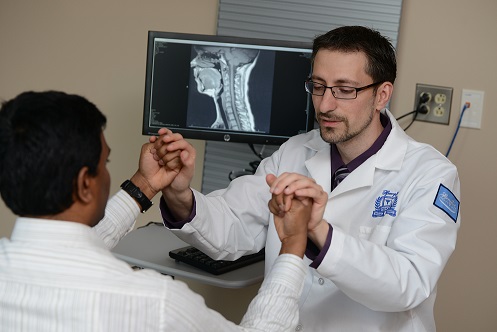Peripheral Field Stimulation
Peripheral field stimulation delivers electrical pulses to small nerve fibers located beneath the skin in the region of pain.

Peripheral field stimulation, also known as peripheral nerve field stimulation, is a type of neurostimulation. In this interventional pain management treatment, a permanent pulse generator is implanted under the skin. This neurostimulator delivers regular electrical impulses to small peripheral nerve fibers located beneath the skin in the region of pain, blocking these pain messages before they can reach the brain. The implanted device is small, like a pacemaker, and does not interfere with normal daily activities. Peripheral nerve stimulation therapy may help to reduce dependence on oral pain medications.
Peripheral field stimulation vs. peripheral nerve stimulation
Peripheral nerve field stimulation and peripheral nerve stimulation are similar in that both procedures target nerves outside of the brain and spinal cord. However, they differ based on the approach to pain management:
- Peripheral field stimulation: Targets smaller nerve fibers located under the skin in the actual region that’s in pain
- Peripheral nerve stimulation: Targets the major peripheral nerve that is located deeper in the body and which supplies the region in pain
Conditions treated by peripheral field stimulation
Peripheral nerve field stimulation is used in the treatment of:
- Peripheral neuropathy (nerve damage and pain), including diabetic neuropathy
- Complex regional pain syndrome (CRPS)
- Chronic headaches
- Occipital neuralgia (a condition that can cause severe headaches)
Your Henry Ford Pain Management specialist will work with you to determine whether a neurostimulation therapy (peripheral field stimulation, peripheral nerve stimulation or spinal cord stimulation) or other interventional pain management treatment is best for your pain condition.
Peripheral nerve field stimulation is performed in two separate procedures
The two peripheral nerve stimulation procedures include:
- Initial trial electrodes: An initial procedure to connect an external, trial pulse generator. This is used to test the effectiveness of the treatment before proceeding to the permanent pulse generator.
- Permanent neurostimulator implant: If pain is reduced by 50 percent during the initial test period, you will undergo a second procedure to implant a permanent pulse generator under your skin for long-term pain management.
Procedure 1: Initial trial electrodes
During this minimally invasive procedure:
- You lie on your stomach.
- Your skin is sterilized at the injection site.
- You will be administered a local anesthetic to numb the injection area.Your pain management physician inserts wires (leads) through a needle and under your skin in the target region.
- These leads are then connected externally to a smartphone-sized electrical pulse generator that you carry with you during the initial test period.
Procedure 2: Implanting the permanent neurostimulator
This surgery is performed under general anesthesia. During this procedure:
- You lie on your stomach.
- Your skin is sterilized at the surgical site.
- You are administered general anesthesia.
- Your pain management physician connects the existing leads from the test pulse generator to a smaller neurostimulator and implants this permanent device under your skin.
Following each peripheral field stimulation procedure
You will be moved to a recovery room and monitored by your care team. In most cases, peripheral nerve field stimulation procedures are performed on an outpatient basis and you will go home the same day, although in rare cases some patients may require admission to the hospital following the procedure.
The Henry Ford Pain Center approach
At the Henry Ford Pain Center, pain treatment begins with a thorough medical history and physical exam. All patients are evaluated by board-certified pain medicine physicians, physician assistants and certified nurse practitioners to identify the cause of their pain. Following initial assessment, we work with you to develop a personalized treatment plan that may include interventional pain procedures, medication therapy, physical therapy, massage and other complementary options.
.svg?iar=0&hash=F6049510E33E4E6D8196C26CCC0A64A4)

/hfh-logo-main--white.svg?iar=0&hash=ED491CBFADFB7670FAE94559C98D7798)